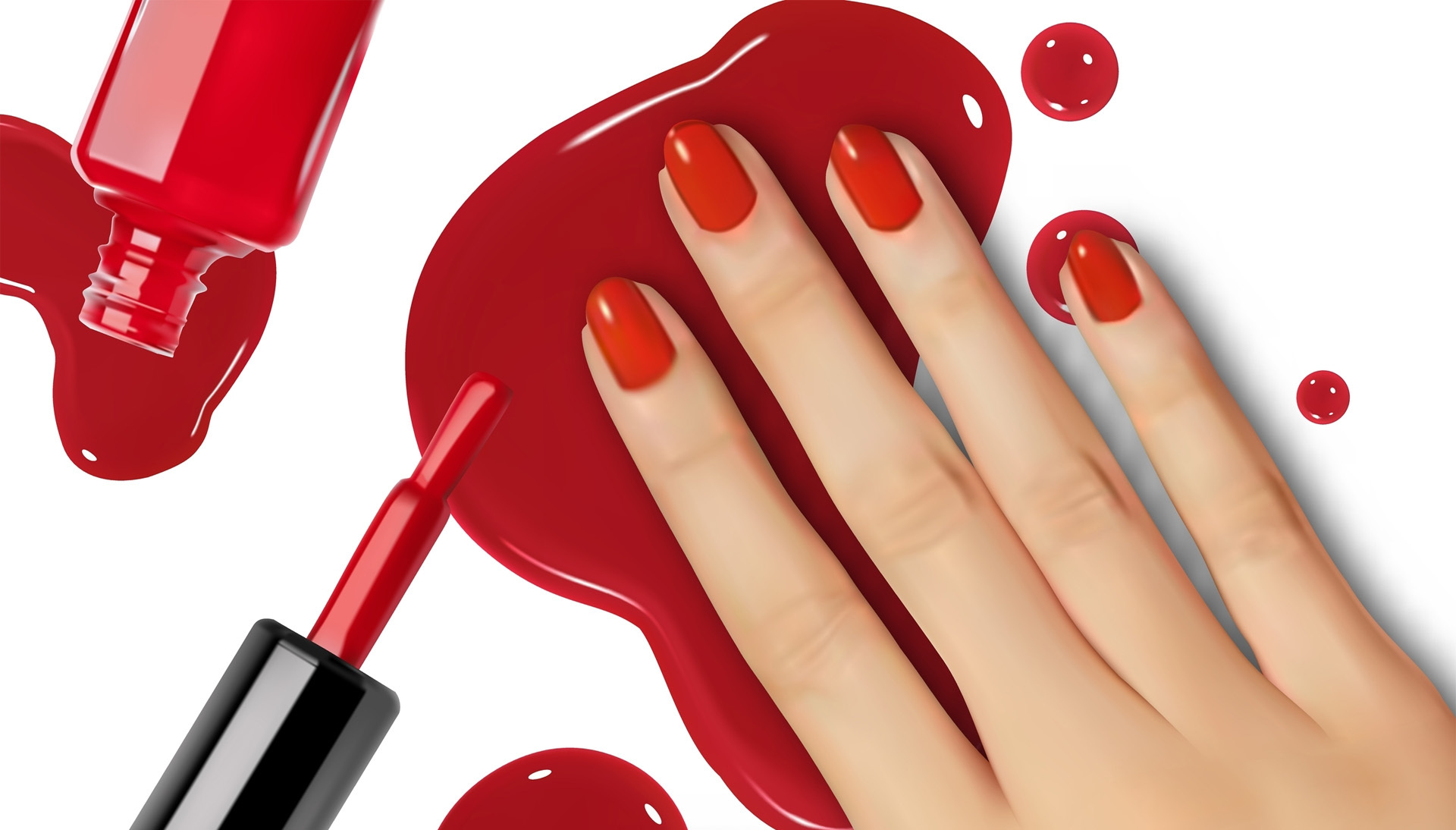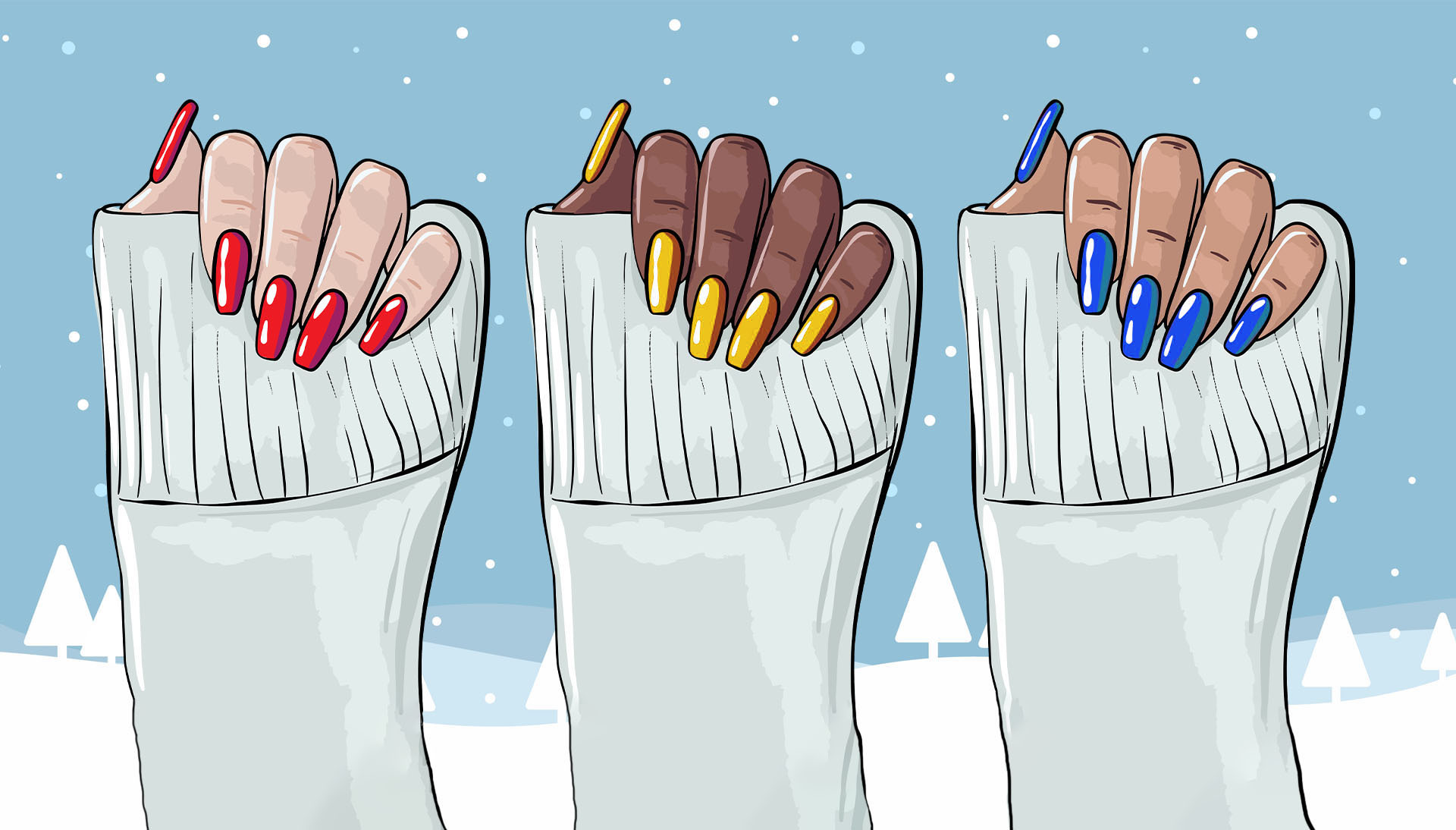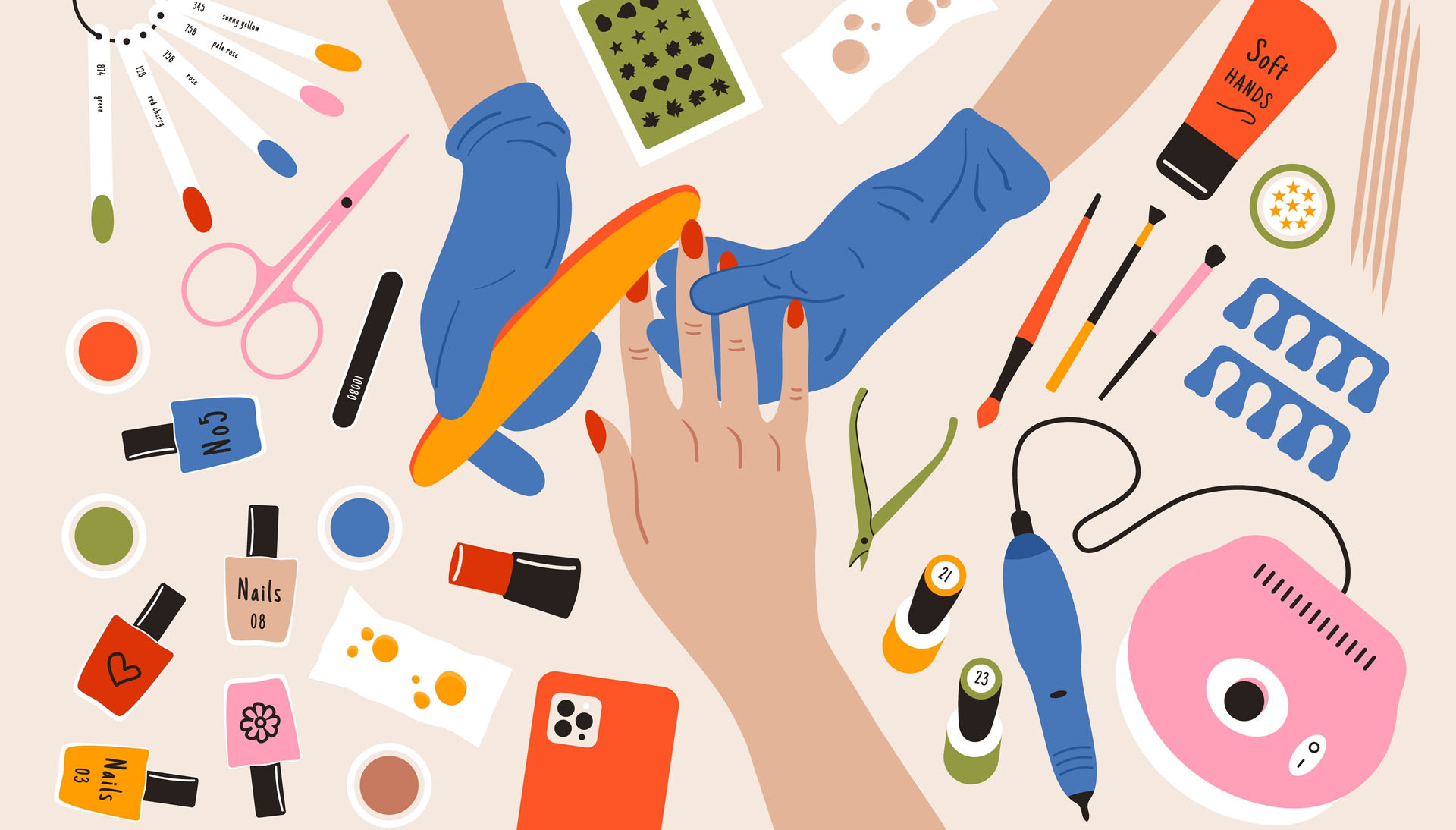Table Of Contents
- 1 Introduction
- 2 Understanding Nail Fungus
- 3 Maintaining Good Hygiene Practices
- 4 NailCare Essentials
- 4.1 Maintaining Nail Health and Appearance
- 4.2 Preventing Nail Odor
- 4.3 Proper Drying to Avoid Moisture-Related Issues
- 4.4 Avoiding Nail Damage
- 4.5 How To Do Gel Nails Professionally: Tips And Tricks
- 4.6 Winter Wonderland Nails: The Ultimate Guide to Trending Colors of 2023
- 4.7 How to do French Manicure At Home?: DIY Steps
- 4.8 Tips for maintaining clean and dry nails
- 5 Protecting Your Nails in Public Areas: Minimizing the Risk of Nail Fungus
- 5.1 Understanding the Risk of Nail Fungus in Public Places
- 5.2 Recognizing the Signs of Nail Fungus
- 5.3 Practicing Proper Foot Hygiene
- 5.4 Wearing Protective Footwear
- 5.5 Using Disinfectants
- 5.6 Avoiding Direct Contact with Contaminated Surfaces
- 5.7 Choosing a Reputable Nail Salon
- 5.8 Practicing Regular Nail Maintenance
- 6 Taking Care of Your Nail Tools
- 7 Choosing the Right Nail Products: Enhancing Nail Health and Beauty
- 8 Maintaining a Balanced Diet for Nail Health
- 9 Seeking Professional Help for nail fungus
- 10 Conclusion
Introduction
Are you tired of dealing with stubborn nail fungus that just won’t go away? Seeking professional help may be the solution you’ve been searching for. When it comes to effectively curing nail fungus, turning to a dermatologist or podiatrist can make all the difference. Don’t let nail fungus hold you back any longer. Discover the benefits of professional intervention and take the necessary steps to regain your nail health. Say goodbye to the frustration and embarrassment of nail fungus and hello to beautiful, healthy nails once again. Let’s delve into the world of professional help for nail fungus and unlock the secrets to effective treatment.
Understanding Nail Fungus
Nail fungus, medically known as onychomycosis, is a common condition that affects millions of people worldwide. While it may initially seem like a cosmetic concern, nail fungus can significantly impact the health and appearance of the nails if left untreated.
Nail fungus
Nail fungus is a fungal infection that primarily affects the nails, most commonly the toenails. It is caused by various fungi, including dermatophytes, yeasts, and molds, which thrive in warm and moist environments. The infection typically begins at the edge of the nail and gradually spreads deeper into the nail bed, leading to thickening, discoloration, and brittleness of the nails.
How it affects the nails
- Thickening: One of the most common signs of nail fungus is nail thickening. As the infection progresses, the affected nail may become thicker than usual. This can make it difficult to trim the nails properly and can cause discomfort while wearing shoes.
- Discoloration: Nail fungus often causes the nails to change color. The infected nail may develop yellow, brown, or even black spots or streaks. In some cases, the entire nail may become discolored. These changes in color can be unsightly and may cause embarrassment.
- Brittleness: Infected nails tend to become brittle and prone to breaking or crumbling. The nails may lose their natural strength and become weak and fragile. This can make it challenging to grow the nails long or maintain their shape.
- Deformation: Nail fungus can cause the nails to become deformed or misshapen. The infected nails may develop an irregular or distorted appearance. They may have ridges, bumps, or a warped shape. This can further contribute to the overall unattractive and unhealthy appearance of the nails.
- Lifting of the nail: As the fungal infection progresses, it can cause the affected nail to lift from the nail bed. This condition, known as onycholysis, creates a gap between the nail and the nail bed, which can accumulate debris and increase the risk of further infection. It may also lead to pain, discomfort, and an increased risk of injury.
- Odor: Nail fungus can give rise to a foul odor emanating from the affected nails. The combination of the fungal infection and the accumulation of debris under the lifted nail can create an unpleasant smell. This can be particularly bothersome and embarrassing.
- Secondary bacterial infection: In some cases, nail fungus can lead to a secondary bacterial infection. The compromised condition of the nail, along with the presence of moisture and debris, creates an environment conducive to bacterial growth. This can cause additional symptoms such as redness, swelling, pain, and pus formation.
Causes and Common Risk Factors
Nail fungus is primarily caused by a group of fungi called dermatophytes. These fungi thrive in warm and moist environments, making nails susceptible to infection. Other types of fungi, such as yeast and mold, can also contribute to nail fungal infections. The following factors can increase the risk of developing nail fungus:
- Poor Nail Hygiene: Neglecting proper nail hygiene, such as not keeping nails clean and dry, can create an environment favorable for fungal growth.
- Trauma or Injury: Any injury or trauma to the nails, such as cracks, splits, or damage to the nail bed, can provide an entry point for fungi.
- Warm and Humid Environments: Prolonged exposure to warm and humid environments, such as swimming pools, public showers, and saunas, can increase the risk of fungus infection.
- Weakened Immune System: Individuals with a weakened immune system, such as those with diabetes, HIV/AIDS, or undergoing immunosuppressive treatments, are more susceptible to nail fungus.
- Diabetes: Diabetes can affect blood circulation and nerve function, making individuals with diabetes more prone to fungal infections, including nail fungus.
- Age: The risk of nail fungus increases with age, as nails tend to become more brittle and prone to damage.
- Sharing Personal Items: Sharing items like nail clippers, files, or footwear with an infected individual can facilitate the spread of nail fungus.
- Certain Medical Conditions: Certain medical conditions, such as peripheral vascular disease or psoriasis, can contribute to nail fungal infections.
- Prolonged Moisture: Continuous exposure to moisture, such as sweaty feet or wearing damp socks and shoes for an extended period, can create an environment conducive to fungal growth.
- Poor Circulation: Conditions that affect blood circulation, such as peripheral artery disease, can compromise the body’s ability to fight off infections, including nail fungus.
By understanding the causes and risk factors associated with nail fungus, individuals can take proactive measures to prevent its occurrence. Maintaining good nail hygiene, wearing breathable footwear, keeping nails dry, avoiding sharing personal items, and addressing underlying health conditions are essential steps in reducing the risk of nail fungal infections.
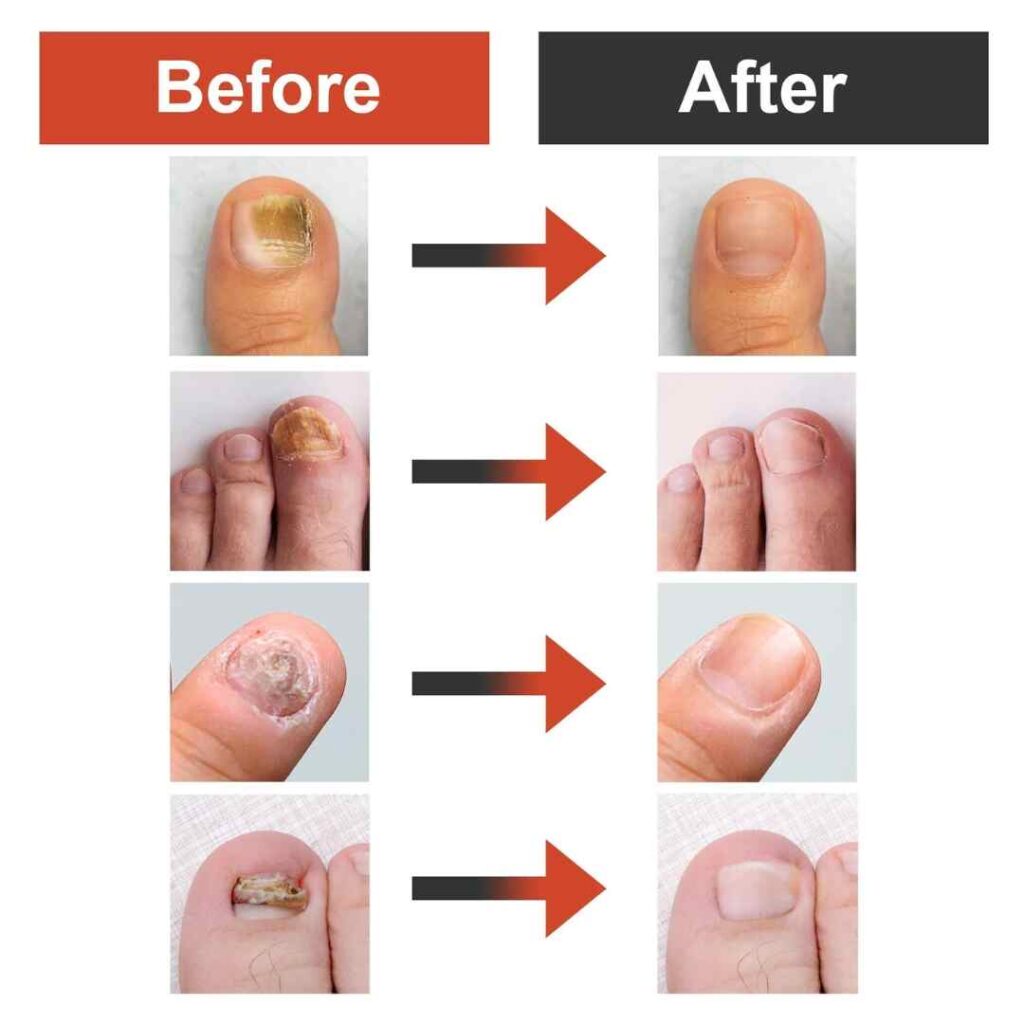
Maintaining Good Hygiene Practices
Proper nail cleaning and drying techniques are crucial aspects of maintaining good nail hygiene. Neglecting these practices can lead to the accumulation of dirt, bacteria, and moisture, which can result in various nail problems. By understanding the significance of proper nail cleaning and drying, we can ensure the health and cleanliness of our nails. These techniques are essential, and we should incorporate them into our nail care routine.
Preventing Bacterial and Fungal Infections
Nails can harbor bacteria and fungi, especially when they come into contact with dirt and moisture. Proper cleaning helps remove these potential pathogens, reducing the risk of infection. Bacterial and fungal infections can cause nail discoloration, brittleness, and even nail bed damage. By cleaning your nails regularly, you minimize the chances of developing such infections.
To clean your nails effectively, start by using a mild soap or gentle cleanser and warm water. Gently scrub the nails and surrounding areas with a soft brush to remove any dirt or debris. Pay attention to the nail folds and the space under the nails, as these are common areas where bacteria can accumulate.
NailCare Essentials
Elevate Your Nail Health and Beauty
Maintaining Nail Health and Appearance
Clean nails not only promote good hygiene but also contribute to their overall health and appearance. When dirt and bacteria accumulate, they can lead to discoloration, yellowing, and an unhealthy appearance. By keeping your nails clean, you can maintain their natural shine and beauty.
Preventing Nail Odor
Poor nail hygiene can lead to unpleasant nail odor. Bacteria and fungi thrive in moist environments, and when trapped under the nails, they can produce a foul smell. Regular cleaning helps remove the debris and moisture that contribute to nail odor, keeping your nails fresh and odor-free.
Proper Drying to Avoid Moisture-Related Issues
After cleaning your nails, it is equally important to ensure they are thoroughly dried. Moisture trapped under the nails can lead to the softening of the nail bed, making it more susceptible to damage and infection. Improper drying can also contribute to the development of nail fungus, as fungi thrive in damp environments.
To dry your nails properly, gently pat them with a clean towel or use a hairdryer in a cool setting. Make sure to pay attention to the spaces between the toes and fingers, as these areas tend to trap moisture. Avoid using excessive heat, as it can dehydrate the nails and surrounding skin.
Avoiding Nail Damage
Rough handling or using harsh tools during nail cleaning can cause damage to the nails and surrounding skin. It is important to be gentle and use appropriate tools to clean your nails. Avoid using sharp objects or metal tools that can scratch the nail surface or cause injury.
Incorporating proper nail cleaning and drying techniques into your routine is essential for maintaining good nail hygiene. By following these practices, you can prevent bacterial and fungal infections, maintain the health and appearance of your nails, prevent nail odor, and avoid moisture-related issues. Remember to clean your nails regularly, pay attention to the nail folds and spaces underneath, and dry them thoroughly to promote healthy and beautiful nails.
Tips for maintaining clean and dry nails
Keeping your nails clean and dry is an essential part of maintaining good nail hygiene. By following practical tips and incorporating them into your daily routine, you can ensure the cleanliness and health of your nails. In this section, we will explore some effective tips for maintaining clean and dry nails
Regular Nail Cleaning
Regularly cleaning your nails is the first step towards maintaining good nail hygiene. Start by using a mild soap or gentle cleanser and warm water to wash your hands and nails. Gently scrub the nails and surrounding areas with a soft brush to remove dirt, bacteria, and debris. Pay special attention to the spaces between the nails and the nail folds, where bacteria can accumulate. Rinse thoroughly and pat dry with a clean towel.
Trim and Shape Your Nails
Keeping your nails trimmed and well-shaped is not only aesthetically pleasing but also contributes to good hygiene. Use sharp and clean nail clippers or a nail file to trim and shape your nails regularly. Avoid excessively long nails, as they are more prone to trapping dirt and bacteria. Be cautious not to trim your nails too short, as this can cause discomfort and increase the risk of nail infections.
Use an Antifungal Nail cleaner.
If you are prone to fungal nail infections or suspect the presence of nail fungus, consider using an antifungal nail cleanser. These specialized cleansers contain ingredients that help kill or inhibit the growth of fungus. Follow the instructions provided and incorporate them into your regular nail cleaning routine for added protection against fungal infections.
- Dry Your Nails Thoroughly
Proper drying of your nails is crucial to preventing moisture-related issues and the growth of bacteria or fungi. After washing your hands or cleaning your nails, make sure to dry them thoroughly. Use a clean towel and gently pat your nails until they are completely dry. Pay attention to the spaces between your fingers and toes, as moisture can accumulate in these areas. Avoid using rough towels or tissues that may cause friction and damage to the nail surface.
- Avoid Excessive Moisture Exposure
Excessive moisture exposure can weaken the nails and make them more susceptible to infections. Take steps to minimize prolonged contact with water or moisture. Wear gloves when doing household chores that involve prolonged exposure to water, cleaning agents, or chemicals. Avoid prolonged soaking of your nails in water, such as in hot tubs or baths. If your nails do come into contact with water, make sure to dry them thoroughly afterward.
- Practice Good Hand Hygiene
In addition to maintaining clean and dry nails, it is essential to practice good hand hygiene. Wash your hands regularly with soap and water, especially before and after handling food, using the restroom, or coming into contact with potentially contaminated surfaces. Use hand sanitizers containing at least 60% alcohol when soap and water are not readily available. Keeping your hands clean reduces the risk of transferring bacteria or fungi to your nails.
- Avoid Nail Biting and Picking
Nail biting and picking not only damage the nails but also introduce bacteria and fungi into the nail bed. These habits can lead to infections and other nail-related problems. If you struggle with nail-biting or picking, consider using bitter-tasting nail polish or behavioral techniques to break the habit. Keeping your nails intact and free from damage is crucial for maintaining good nail hygiene.
- Be Mindful of Nail Care Products
When selecting nail care products, opt for reputable brands and products that are specifically formulated for nail health. Avoid using harsh chemicals or acetone-based nail polish removers, as they can dry out the nails and weaken them over time. Look for nourishing and moisturizing nail products that help maintain the health and strength of your nails.
Protecting Your Nails in Public Areas: Minimizing the Risk of Nail Fungus
When it comes to maintaining healthy nails, it’s essential to be aware of the potential risks that can arise from visiting public areas. Nail fungus, a common concern for many individuals, can easily spread in environments where moisture and warmth are prevalent.
Understanding the Risk of Nail Fungus in Public Places
Public areas, such as swimming pools, locker rooms, gyms, and nail salons, are frequented by numerous individuals, increasing the likelihood of exposure to fungal infections. Fungi thrive in warm and moist environments, making these places ideal breeding grounds. Understanding the risk of nail fungus in public areas is crucial for taking proactive steps to safeguard your nails.
Recognizing the Signs of Nail Fungus
Before diving into preventive measures, it’s important to familiarize yourself with the signs of nail fungus. Common symptoms include discoloration of the nail, thickening, brittleness, a distorted shape, and the presence of debris under the nail. If you notice any of these symptoms, it’s advisable to seek professional guidance for an accurate diagnosis and treatment.
Practicing Proper Foot Hygiene
Maintaining good foot hygiene is a fundamental step in protecting your nails from fungal infections in public areas. Start by washing your feet regularly with warm water and mild soap regularly. Be sure to thoroughly clean the spaces between your toes and remove any dirt or debris. Afterward, dry your feet completely, paying extra attention to the areas that tend to retain moisture. Moisturizing your feet with a non-greasy lotion can help keep the skin hydrated without creating a favorable environment for fungal growth.
Wearing Protective Footwear
One of the most effective preventive measures against nail fungus in public places is wearing protective footwear. When using communal showers, walking around pool areas, or navigating locker rooms, opt for waterproof sandals or flip-flops. These types of footwear create a barrier between your feet and potentially contaminated surfaces, reducing the chances of fungal spores making direct contact with your nails.
Using Disinfectants
Another important step in protecting your nails is to use disinfectants after visiting public areas. Disinfecting sprays or wipes can be used to clean the surfaces of public showers, gym equipment, and other shared facilities. It’s advisable to carry a small bottle of hand sanitizer containing at least 60% alcohol to sanitize your hands and any objects you may have touched, such as doorknobs or handrails.
Avoiding Direct Contact with Contaminated Surfaces
To minimize the risk of nail fungus, it’s crucial to avoid direct contact with potentially contaminated surfaces. This includes avoiding walking barefoot in public areas like locker rooms, saunas, or poolside areas. Instead, keep your feet protected by wearing socks or shoes. Additionally, refrain from sharing personal items such as towels, socks, or nail care tools with others to reduce the chances of spreading or contracting fungal infections.
Choosing a Reputable Nail Salon
If you visit nail salons, it’s important to select a reputable establishment that prioritizes hygiene and sanitation. Before booking an appointment, research the salon’s practices and read customer reviews. Ensure that the salon follows strict protocols for sterilizing tools, using disposable files, and maintaining clean and sanitized workstations. Taking these precautions can significantly lower the risk of fungal infections during nail treatments.
Practicing Regular Nail Maintenance
Maintaining regular nail care is essential for protecting your nails in public areas. Trim your nails regularly to keep them short and prevent dirt or debris from accumulating under the nail bed. Avoid using sharp or contaminated tools that can damage the nail or increase the risk of infection. If you notice any changes in your nails, such as discoloration or thickening, seek professional advice promptly to address any potential issues.
When it comes to achieving beautiful and healthy nails, it’s not just about the nail polish colors or the techniques used. The cleanliness and sanitization of your nail tools play a crucial role in maintaining the overall hygiene of your nail care routine. In this section, we will delve into the importance of regularly cleaning and sanitizing nail tools and provide step-by-step instructions for cleaning different types of tools. By following these practices, you can ensure that your tools are free from bacteria, fungi, and other harmful microorganisms, promoting healthier nails and a safer nail care experience.
Taking Care of Your Nail Tools
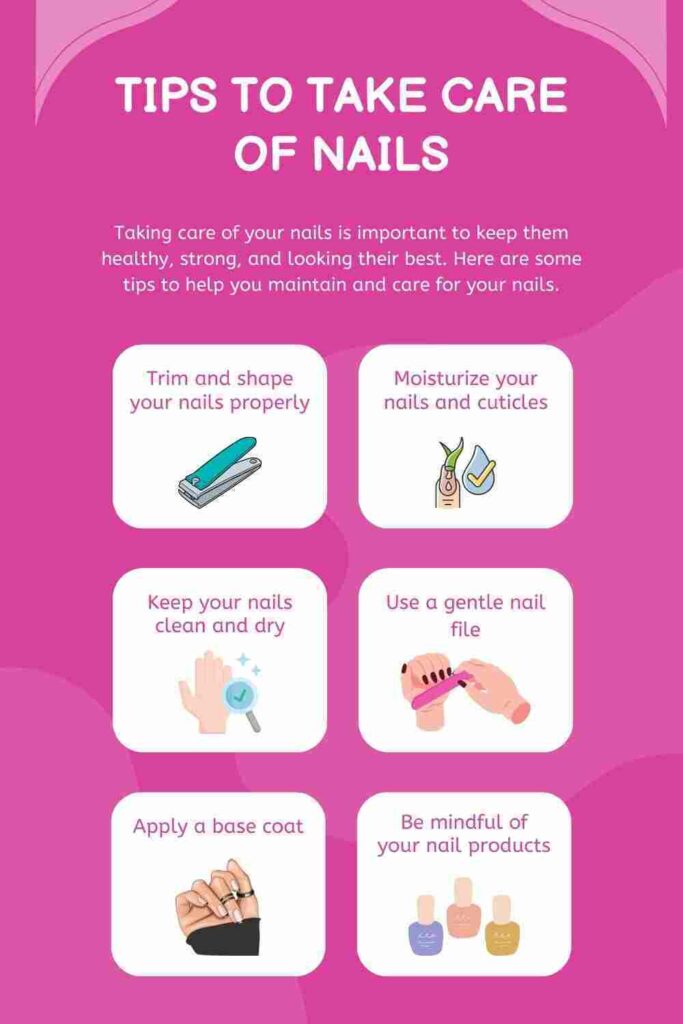
The Importance of Regularly Cleaning and Sanitizing Nail Tools
- Regularly cleaning and sanitizing nail tools is crucial for maintaining healthy nails and preventing infections.
- Dirty tools can harbor bacteria and fungi, which can lead to nail problems and infections.
- Cleaning and sanitizing tools help prevent the spread of infections and protect the overall health of your nails.
- Proper cleaning and sanitization also contribute to the longevity and effectiveness of your nail tools.
- Removing debris and residue from tools ensures their sharpness, precision, and optimal performance.
- Clean and sanitized tools create a safer and more hygienic environment for your nails, reducing the risk of skin irritation or allergic reactions.
- To clean nail tools, start by rinsing them with warm water to remove visible debris.
- Use a mild antibacterial soap or specialized tool cleaner to cleanse the surfaces of the tools.
- Gently scrub the tools with a soft brush or toothbrush to remove stubborn dirt or product buildup.
- Rinse the tools again with warm water to remove any traces of soap.
- Dry the tools completely using a clean towel or allow them to air-dry before storing them in a clean and dry container.
- By incorporating regular cleaning and sanitization into your nail care routine, you promote healthier nails and maintain a hygienic environment.
Here Are Some Tips to Get Stronger Nails Naturally.
Step-by-Step Instructions for Cleaning Different Types of Tools
- Metal Tools (such as nail clippers, cuticle pushers, and tweezers)
- Start by removing any debris or nail residue from the tools using a soft brush or a toothbrush.
- Prepare a bowl of warm water with a mild antibacterial soap or a gentle dishwashing liquid.
- Place the metal tools in the soapy water and let them soak for a few minutes.
- Use a clean, soft cloth or a brush to gently scrub the tools, paying extra attention to the crevices and edges.
- Rinse the tools thoroughly under warm running water to remove any soap residue.
- Pat dry the tools with a clean towel and allow them to air-dry completely before storing them in a clean, dry container.
- Nail Files and Buffers
- For disposable nail files and buffers, it’s best to use a new one for each client or for personal use.
- If you have reusable nail files or buffers, start by removing any nail debris by gently tapping or brushing them.
- Fill a bowl with warm water and a few drops of antibacterial soap or dishwashing liquid.
- Place the files or buffers in the soapy water and let them soak for a few minutes.
- Use a soft brush or an old toothbrush to gently scrub the files or buffers, ensuring that all surfaces are thoroughly cleaned.
- Rinse the tools under warm running water to remove any soap residue.
- Pat dry the tools with a clean towel and let them air-dry completely before storing them in a clean container.
- Brushes (such as nail art brushes or gel brushes)
- Remove any excess nail polish or product from the brush by wiping it on a lint-free paper towel or a cotton pad.
- Pour a small amount of brush cleaner or gentle liquid soap into a bowl.
- Dip the bristles of the brush into the cleaner and gently swirl it around to loosen any remaining product.
- Rinse the brush under warm running water while gently massaging the bristles to remove the cleaner and residue.
- Pat the brush dry with a clean towel, and reshape the bristles if necessary.
- Allow the brush to air-dry completely before storing it in a clean and dry container.
Additional Tips for Maintaining Clean Nail Tools
- Clean your nail tools after each use to prevent the buildup of bacteria and germs.
- Avoid sharing nail tools with others to reduce the risk of infection transmission.
- Store your cleaned and dried nail tools in a clean and dry container to protect them from dust and contamination.
- Regularly inspect your nail tools for any signs of wear or damage. Replace them if needed to ensure safe and effective use.
By following these step-by-step instructions and implementing proper cleaning and sanitization practices, you can maintain clean and hygienic nail tools. This will not only protect you from potential infections but also contribute to the overall health and well-being of your nails. Remember, clean tools lead to healthy nails, so make it a priority to care for your tools as diligently as you care for your nails.
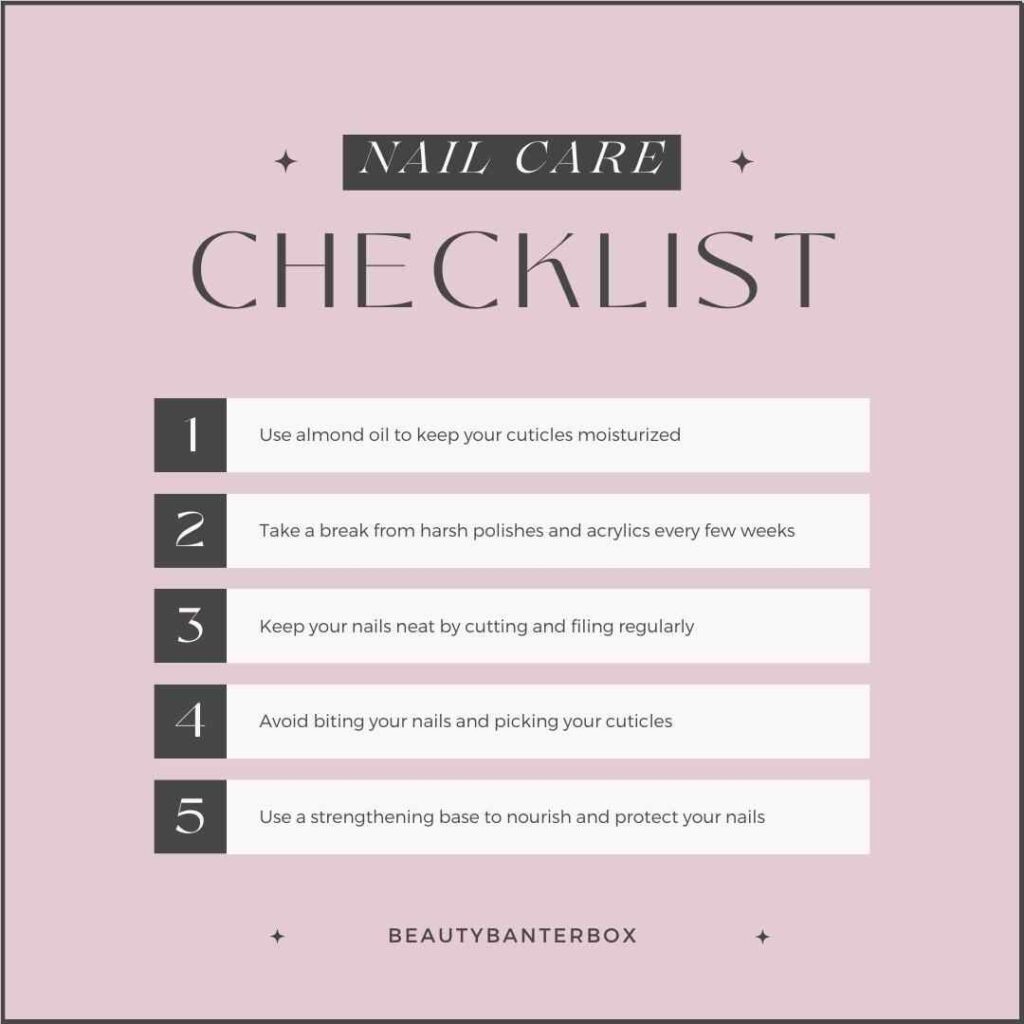
Choosing the Right Nail Products: Enhancing Nail Health and Beauty
Taking care of your nails goes beyond regular cleaning and maintenance. Using the right nail products is equally important to ensure the health and beauty of your nails.
The Importance of Using Quality and Nail-Friendly Products
- Nail health: High-quality nail products are formulated with ingredients that promote nail health, such as vitamins, proteins, and moisturizers. These products nourish and strengthen the nails, reducing the risk of breakage and brittleness.
- Avoiding harmful chemicals: Low-quality nail products often contain harmful chemicals such as formaldehyde, toluene, and DBP (dibutyl phthalate). These chemicals can cause nail damage, dryness, and irritation. Opting for nail products that are free from these toxic ingredients helps protect your nails and overall health.
- Long-lasting results: Quality nail polishes and treatments offer better longevity and color payoff. They adhere well to the nails and resist chipping and peeling, ensuring your manicure or pedicure lasts longer.
Guidance on selecting nail polishes, removers, and other nail care essentials
Selecting Nail Polishes
- Look for reputable brands: Choose nail polish brands known for their quality and reputation. They are more likely to use safe and nail-friendly ingredients in their formulations.
- Consider the formulation: Opt for nail polishes that are free from harmful chemicals like formaldehyde, toluene, and DBP. Look for labels that indicate “3-free,” “5-free,” or “10-free,” which means they are formulated without certain harmful chemicals.
- Nail-friendly ingredients: Some nail polishes contain nourishing ingredients like vitamins, keratin, and natural oils. These ingredients provide added benefits to the nails, keeping them healthy and strong.
- Color selection: Choose a wide range of colors that suit your preferences and occasions. From vibrant shades to subtle neutrals, having a variety of colors allows you to express your style and creativity.
Nail Polish Removers
- Gentle formulas: Opt for acetone-free nail polish removers as they are less drying and damaging to the nails. Acetone-based removers can strip the nails of their natural oils, leading to dryness and brittleness.
- Moisturizing properties: Look for nail polish removers that contain moisturizing ingredients like glycerin or oils. These help to nourish the nails and cuticles while removing the polish effectively.
- Wipes or liquid removers: Choose between nail polish remover wipes or liquid removers based on your preferences. Wipes offer convenience and portability, while liquid removers often come in larger bottles and can be used with cotton pads or swabs.
Other Nail Care Essentials
- Nail strengtheners and treatments: Consider using nail strengtheners and treatments that are designed to improve the overall health and strength of your nails. These products help address specific nail concerns like brittleness, splitting, or peeling.
- Cuticle care products: Invest in cuticle oils or creams to keep your cuticles moisturized and healthy. Regular application of cuticle care products helps prevent dryness, cracking, and hangnails.
- Tools and accessories: Ensure that you have high-quality nail tools like clippers, files, and buffers. These tools should be sharp, clean, and properly sanitized to prevent damage to the nails.
Maintaining a Balanced Diet for Nail Health
When it comes to achieving strong and healthy nails, it’s not just external care that matters. Your diet plays a crucial role in providing the necessary nutrients for nail growth and maintenance.
The Role of Nutrition in Promoting Strong and Healthy Nails
- Nail structure: Nails are composed of a protein called keratin. Adequate protein intake is essential for the production of strong and resilient nails. Without proper protein supply, nails can become weak, brittle, and prone to breakage.
- Nail growth: Certain vitamins and minerals play a crucial role in nail growth. They contribute to the production of new nail cells and promote overall nail health. Nutrient deficiencies can lead to slow nail growth and affect the appearance and strength of the nails.
- Nail moisture and flexibility: Hydration is vital for maintaining nail moisture and flexibility. Proper water intake and consumption of hydrating foods help prevent dry and brittle nails.
Key Nutrients for Nail Health
- Protein
- Essential for the production of keratin, the main structural component of nails.
- Include lean meats, poultry, fish, eggs, legumes, nuts, and seeds in your diet.
- Biotin
- Promotes nail strength and thickness.
- Good sources include eggs, salmon, avocados, nuts, seeds, and sweet potatoes.
- Iron
- Helps deliver oxygen to the nail bed, promoting nail growth.
- Include iron-rich foods such as lean meats, spinach, lentils, and fortified cereals.
- Vitamin C
- Plays a role in collagen synthesis, which contributes to nail strength.
- Incorporate citrus fruits, berries, kiwis, bell peppers, and leafy greens into your meals.
- Vitamin E
- Protects the nails from oxidative damage and helps retain moisture.
- Find vitamin E in foods like almonds, sunflower seeds, spinach, and broccoli.
- Omega-3 Fatty Acids
- Promote nail hydration and flexibility.
- Include fatty fish like salmon, mackerel, and sardines, as well as flaxseeds and walnuts.
Foods for Nail Health
- Lean meats and poultry are rich in protein, zinc, and iron, which are essential for nail health and growth.
- Fish and seafood are excellent sources of omega-3 fatty acids, protein, and minerals that promote nail strength and moisture.
- Eggs: Provide biotin, protein, and vitamins necessary for healthy nail growth.
- Nuts and seeds: Contain biotin, vitamin E, and minerals that support nail health and prevent brittleness.Colorful fruits and vegetables are rich in vitamins, antioxidants, and water content, which promote nail hydration, strength, and overall health.
- Whole grains: Provide B vitamins and minerals like zinc, promoting nail growth and preventing deficiencies.
Seeking Professional Help for nail fungus
Dealing with nail fungus can be a frustrating and challenging experience. While there are various home remedies and over-the-counter treatments available, seeking professional help is often the best course of action.
When to Seek Professional Help
- Persistent or worsening symptoms: If you have been trying home remedies or over-the-counter treatments for an extended period with no improvement, it’s time to consult a professional. Persistent or worsening symptoms such as thickened nails, discoloration, pain, or discomfort indicate the need for expert guidance.
- Chronic or recurring nail fungus: If you have a history of chronic or recurring nail fungus infections, it is advisable to consult a professional. They can assess your condition, identify underlying causes, and provide a targeted treatment plan to prevent future recurrences.
- Diabetic or immunocompromised individuals: People with diabetes or weakened immune systems are more susceptible to severe nail fungus infections. Seeking professional help is crucial in managing these cases, as they may require specialized care and monitoring.
The Benefits of Professional Intervention
- Accurate diagnosis: Professionals can accurately diagnose the type and severity of your nail fungus through clinical examination and laboratory tests. This ensures that you receive the most appropriate treatment for your specific condition.
- Tailored treatment plans: Professionals can develop personalized treatment plans based on the severity, location, and underlying causes of your nail fungus. They may recommend a combination of treatments to maximize effectiveness and ensure long-term results.
- Expert guidance: Professionals provide valuable guidance on proper nail care, hygiene practices, and lifestyle modifications to prevent the recurrence of nail fungus. They can also address any concerns or questions you may have throughout the treatment process.
- Access to advanced treatments: Dermatologists and podiatrists have access to advanced treatments and procedures that may not be available over the counter. These include prescription antifungal medications, laser therapy, and surgical interventions for severe cases.
Treatment Options and Procedures
- Prescription antifungal medications: Professionals can prescribe oral antifungal medications or topical treatments with higher concentrations of active ingredients than over-the-counter options. These medications can effectively eliminate the fungus and promote healthy nail regrowth.
- Laser therapy: Laser treatment involves the use of laser energy to target and destroy the fungus without harming the surrounding tissues. It is a non-invasive procedure that can be highly effective in treating stubborn nail fungus.
- Surgical interventions: In severe cases, surgical interventions such as nail removal or debridement may be necessary. These procedures aim to remove the infected nail and allow for the growth of a healthy nail.
- Maintenance and preventive care: Professionals will guide you on post-treatment care and preventive measures to reduce the risk of nail fungus recurrence. This may include regular monitoring, hygiene practices, and the use of antifungal products as recommended.
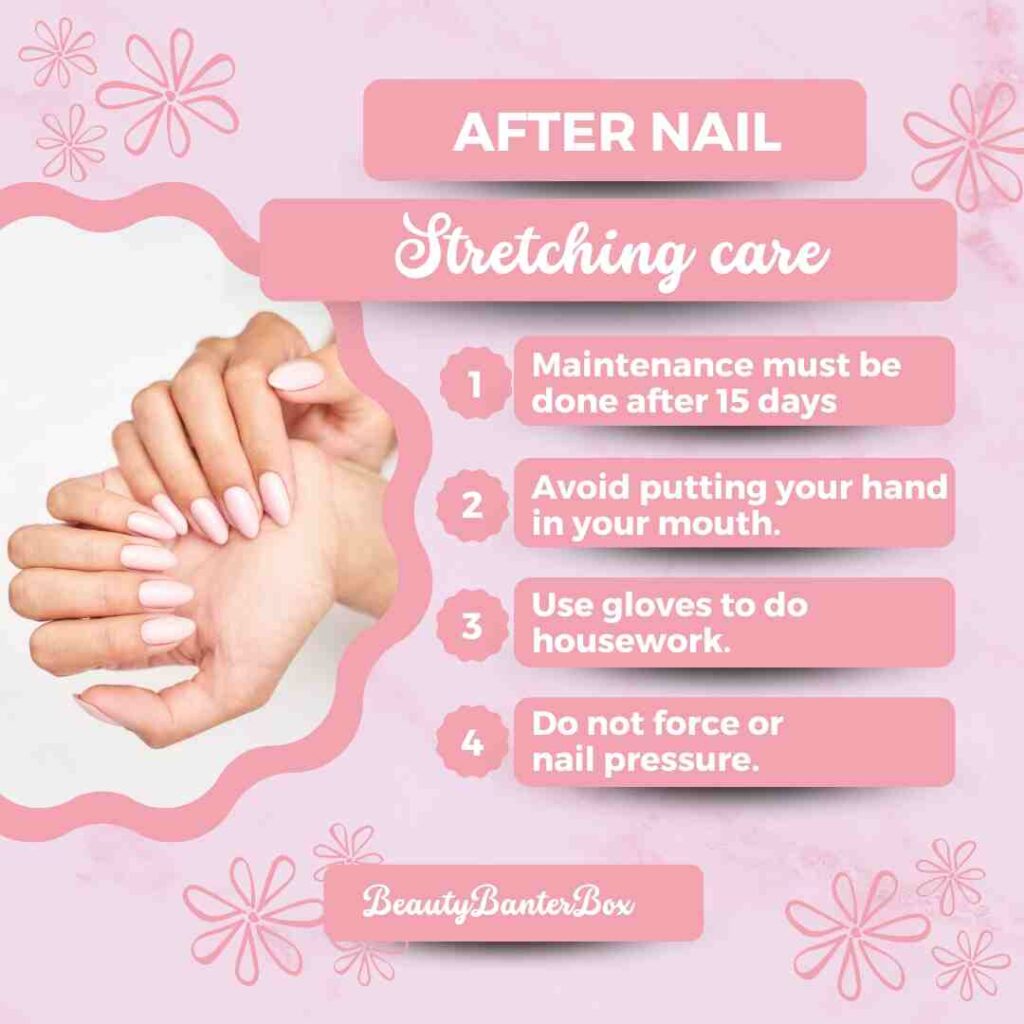
Conclusion
In the quest for beautiful and healthy nails, preventing nail fungus is a paramount concern. By following proper hygiene practices, maintaining a balanced diet, using quality nail products, and seeking professional help when needed, you can effectively prevent nail fungus and maintain healthy nails. Take the necessary precautions to keep your nails clean, dry, and well-maintained, and avoid sharing nail tools. Incorporate nutrient-rich foods into your diet to support nail health, and choose gentle and nail-friendly products for your nail care routine. If nail fungus does occur, seek professional assistance to address it promptly. By prioritizing preventive measures and giving your nails the care they deserve, you can enjoy beautiful and healthy nails all year.


